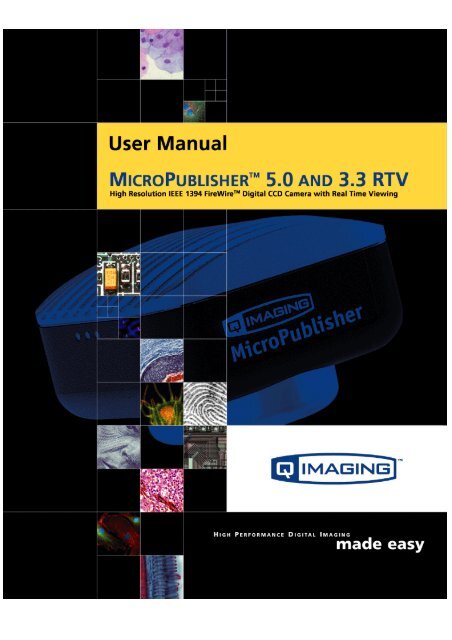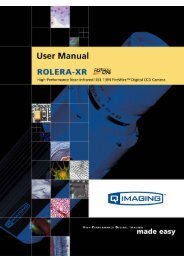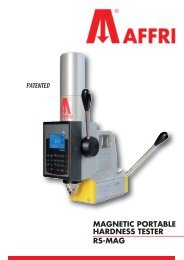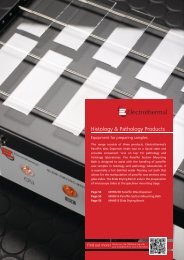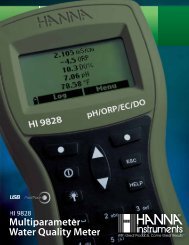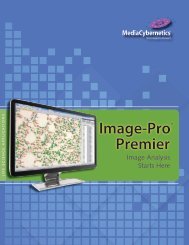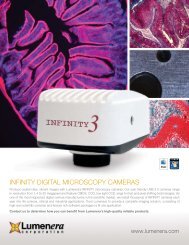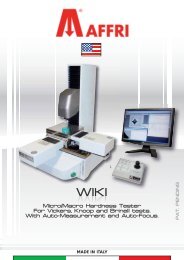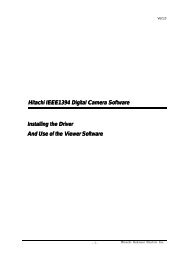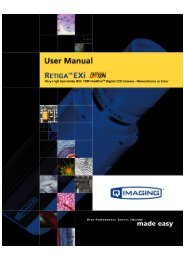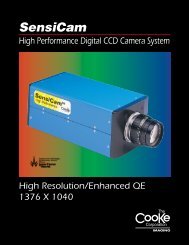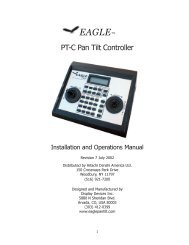MicroPublisher RTV User's Manual - QImaging
MicroPublisher RTV User's Manual - QImaging
MicroPublisher RTV User's Manual - QImaging
Create successful ePaper yourself
Turn your PDF publications into a flip-book with our unique Google optimized e-Paper software.
CONTENTS<strong>MicroPublisher</strong> <strong>RTV</strong> User’s <strong>Manual</strong> ................................................................................. iINTRODUCTION ............................................................................................................. 1Power Requirements ................................................................................................... 1Host Requirements ...................................................................................................... 1IEEE 1394 (FireWire) Interface ................................................................................. 2Cables .......................................................................................................................... 2Imaging Software for Your Camera ........................................................................... 2INSTALLATION .............................................................................................................. 4Step 1. Install the 1394 PCI card (Windows Users Only) .......................................... 4Step 2. Install Your Imaging Software ....................................................................... 5Step 3. Connect the <strong>MicroPublisher</strong> <strong>RTV</strong> .................................................................. 5CAMERA BASICS ........................................................................................................... 9Turning the Camera On and Off ................................................................................. 9Connecting the <strong>MicroPublisher</strong> <strong>RTV</strong> to your Optics ................................................. 9Understanding the LED Indicators ............................................................................. 10Capturing Images with the <strong>MicroPublisher</strong> <strong>RTV</strong> ....................................................... 10CARING FOR YOUR CAMERA ..................................................................................... 11TROUBLESHOOTING ..................................................................................................... 12Resolving Problems with the camera .......................................................................... 12Unresolved Problems - Contacting <strong>QImaging</strong> Support .............................................. 13GLOSSARY ...................................................................................................................... 14ADDENDUM .................................................................................................................... 16Neutral Density (ND) Filter ........................................................................................ 16ii
INTRODUCTIONCHAPTER 1The <strong>QImaging</strong> <strong>MicroPublisher</strong> with Real Time Viewing (<strong>RTV</strong>) delivers unsurpassed interactivity andproductivity by combining ultra high resolution images with video like, full field of view frame ratesof up to 30fps. Scanning, framing and focusing have never been easier than with the <strong>MicroPublisher</strong><strong>RTV</strong>. The 30-bit color digitization produces high quality images of brightfield, dark-field andfluorescence work. For demanding low-light applications, the <strong>MicroPublisher</strong> <strong>RTV</strong> Cooled, minimizesthermal noise during long exposure times. With a IEEE 1394 FireWire digital interface the<strong>MicroPublisher</strong> <strong>RTV</strong> is easy to install requiring a single wire to connect the camera to a computer orlaptop. The <strong>MicroPublisher</strong> <strong>RTV</strong> eliminates expenses, installation problems and inconveniencesassociated with framegrabbers and external power supplies. All cameras ship with Image Capturesoftware. Large selections of specialty software applications are available from <strong>QImaging</strong> softwarepartners and a Software Development Kit (SDK) is available upon request for interfacing the<strong>MicroPublisher</strong> <strong>RTV</strong> with custom software.<strong>MicroPublisher</strong> <strong>RTV</strong> comes in two models:• <strong>MicroPublisher</strong> <strong>RTV</strong> cooled - with a Peltier cooling system to lower the temperature 10°Celsius below ambient to reduce the effects of thermal noise for long integration times.• <strong>MicroPublisher</strong> <strong>RTV</strong> uncooled - for bright field imagingPower RequirementsThe <strong>MicroPublisher</strong> <strong>RTV</strong> can be powered through a single IEEE 1394 (FireWire) cable.• Power:Cooled <strong>MicroPublisher</strong> <strong>RTV</strong> = 7 wattsUncooled <strong>MicroPublisher</strong> <strong>RTV</strong> = 4 watts• Input voltage range: 8 - 24 voltsHost RequirementsFor Windows PCs:• Pentium® CPU, running at 300MHz.• 256 MB RAM.• Video card with 8 MB video memory capable of 32-bit color output.• Microsoft Windows 98 Second Edition, Windows Millennium Edition (ME), Windows 2000,or Windows XP Professional.1
• If the PC is not equipped with a FireWire card, the supplied card must be installed.For Mac OS Computers:• PowerPC-based Macintosh with an OHCI compliant IEEE 1394 port (G4 and iMac®models).• iMac models may not provide enough power to cooled cameras. <strong>QImaging</strong>’s IEEE 1394HUB may be required to power the camera. Contact <strong>QImaging</strong> for ordering information.• Mac OS 9.1, 9.2 or X• 256 MB+ RAM• All the G4 and iMac models are equipped with a FireWire card. The supplied IEEE 1394 PCIis not required for Mac OS computers.IEEE 1394 (FireWire) InterfaceThe <strong>MicroPublisher</strong> <strong>RTV</strong> is powered and controlled through an IEEE 1394 (FireWire) digital interface.A single FireWire connection from the camera to the computer allows full control of the camera andrapid image data transfer from the camera to the computer.CablesA 10-foot FireWire interface cable is included with the camera. One end of this cable connects toeither of the available FireWire ports at the back of the camera; the other end of the cable plugs intoyour computer’s 6-pin FireWire port.Some computers have 4-pin FireWire ports. These ports may be used if they are OHCI compliant, butyou will need to purchase a 4-pin to 6-pin FireWire cable from your local computer store. If youconnect the <strong>MicroPublisher</strong> <strong>RTV</strong> to a 4-pin FireWire port, you likely need to use an external powersupply.What is the difference between 4-pin and 6-pin FireWire ports?FireWire cables are available in two varieties: 4-pin and 6-pin. 6-pin FireWire cables are capable ofproviding both power and a communication interface between the camera and computer while 4-pincables provide only a communication interface. Some laptop computers have 6-pin FireWire jacks thatdo not provide power. If your computer has such a port, you will have to power your <strong>MicroPublisher</strong><strong>RTV</strong> by attaching an external power supply to the system.Imaging Software for Your CameraIndustry Standard Imaging ApplicationsThe <strong>MicroPublisher</strong> <strong>RTV</strong> works with industry-standard Windows and Mac OS imaging software. Pleasego to the following URL for an up to date listing of third party software companies that support<strong>QImaging</strong> cameras. HTTP://WWW.QIMAGING.COM/ALLIANCES/2
QCapture Suite SoftwareThe <strong>MicroPublisher</strong> <strong>RTV</strong> operates on both Windows and Mac OS based systems. QCapture SuiteSoftware for both systems is available at WWW.QIMAGING.COM. The easy-to-use QCapture softwaregives you complete control over the camera’s settings and image capture functions. QCapture Suitealso includes a TWAIN-compliant interface that allows many Windows image-editing applications toacquire images using <strong>QImaging</strong> cameras.3
INSTALLATIONCHAPTER 2IMPORTANT: Follow these steps in order to complete the installation.DO NOT CONNECT the camera until the camera driver is installed.1. Windows PC users only: Install the IEEE 1394 PCI card - only if necessary.2. Imaging Software - Install the software and drivers that your new <strong>QImaging</strong>camera needs to capture images.3. <strong>MicroPublisher</strong> <strong>RTV</strong> - Connect the camera to your computer using the supplied IEEE1394 cable.DO NOT CONNECT the camera until you have a functioning FireWire port inyour computer and the camera driver is installed.Step 1. Install the 1394 PCI card (Windows Users Only)This step is for Windows PC users only. If you are installing the <strong>MicroPublisher</strong> <strong>RTV</strong> on a Mac OScomputer, please skip to Step 2.Check your computer for an existing FireWire port:The <strong>MicroPublisher</strong> <strong>RTV</strong> connects to your Windows PC via a FireWire port. If you already have aFireWire port, you do not have to install the IEEE 1394 PCI card. Check the connectors at the back ofyour PC for a port that matches the FireWire ports on your camera (Figure 1 and Figure 2).CameraComputerFigure 1— 6-pin to 6-pin FireWire (IEEE 1394) Port connectionCameraComputerFigure 2— 6-pin to 4-pin FireWire (IEEE 1394) Port connection4
If your PC does not have a functioning FireWire port, you must install the IEEE 1394 PCI card that camewith your camera.If necessary, install the supplied IEEE 1394 PCI card:• Shut down your computer.• Open the case, and install the supplied IEEE 1394 card into an empty PCI slot. See the user’smanual for your computer for complete instructions on installing new PCI cards.• Restart your computer. Windows should automatically install the appropriate softwaredrivers for the card.Step 2. Install Your Imaging SoftwareOnce the IEEE 1394 card is installed in your computer, you are ready to install the FireWire drivers andimaging software. See your Imaging Software User’s Guide for complete installation instructions.Step 3. Connect the <strong>MicroPublisher</strong> <strong>RTV</strong>Once your imaging software is installed, connect your camera. There are two different types ofconnections. In most cases, the FireWire cable provides the necessary power required by the<strong>MicroPublisher</strong> <strong>RTV</strong>. However, if your camera is cooled you may need to provide additional power tothe camera in one of the ways listed in the following figures. Most noteably, you will need to eitherconnect your camera with a 1394l power supply or through an IEEE 1394 HUB. Both items areavailable from your <strong>QImaging</strong> dealer.5
Connecting the camera to a PC/MAC desktop or MAC laptop ComputerPerform the following for connecting your camera.• Remove the FireWire cable from the camera box, and plug one end of the cable into oneof the camera’s FireWire sockets (either socket is fine).Figure 3— Camera FireWire Sockets.• Plug the other end of the cable into a FireWire port on your computerCameraComputerFigure 4— Desktop Computer FireWire ConnectionThere are some cases when connecting to a PC or Mac desktop or Mac laptop computer where notenough power is supplied through the IEEE 1394 cable. If this is the case, you may receive an Error6
Code 28 or the software not working consistently. In this case, external power must be delivered tothe camera which can be accomplished by connecting the camera via one of the following methods.• Connection of an 1394 power supply with your camera is as follows:CameraComputer110/240 VACFigure 5— FireWire and 1394 Power Supply Connection• Connection of a 1394 IEEE HUB with your camera is as follows:CameraComputer1394 HUB110/240 VACFigure 6— FireWire and IEEE 1394 HUB ConnectionConnecting the camera to a PC laptop computerThere are two common connection varieties for laptop computers;1 Built-In Firewire port, or2 PCMCIA Card.1. Built-In 4-pin or 6-pin Firewire PortThere are cases with PC laptops where a built-in 6-pin FireWire port is available. If this is the casewith your computer, it is possible that the two power pins on the Firewire port have beendisabled, allowing only data communications. If you have such a connection or if you have abuilt-in 4-pin connector, you will need to power the camera.If you purchased a 1394 power supply from <strong>QImaging</strong>, connect your camera as follows:7
ComputerPort2Port1CameraNotConnected110/240 VACFigure 7— FireWire and 1394 Power Supply ConnectionIf you purchased an IEEE 1394 HUB, connect your camera as per the following figure.CameraComputer1394 HUB110/240 VACFigure 8— FireWire and IEEE 1394 HUB Connection2. PCMCIA Card with a 4-pin/6-pin Firewire PortIn some cases, laptop computers have a firewire port from a PCMCIA card. Most of thesePCMCIA cards allow an external connection directly to the card. If this is the case, and thePCMCIA connector is a 6-pin connector, then you should connect the power to your PCMCIAcard and connect your camera as per Figure 9. However, if you have a 4-pin PCMCIA cardFirewire port, then you will need to connect your camera in the configuration of either Figure 7or Figure 8.Computer110/240 VACFigure 9— FireWire and 6-pin IEEE 1394 PCMCIA Connection8
CAMERA BASICSCHAPTER 3The <strong>MicroPublisher</strong> <strong>RTV</strong>’s image capture capabilities are controlled entirely by your imaging software.This chapter provides basic instructions for working with the camera itself.Turning the Camera On and OffTo turn on the <strong>MicroPublisher</strong> <strong>RTV</strong>, all you need to do is to connect one end of your FireWire cableinto one of the <strong>MicroPublisher</strong> <strong>RTV</strong>’s FireWire ports, and the other end of the cable to one of theFireWire ports on the computer’s PCI card.To turn off the <strong>MicroPublisher</strong> <strong>RTV</strong>, simple unplug the FireWire cable from either your camera’sFireWire port or the computer’s FireWire port.Connecting the <strong>MicroPublisher</strong> <strong>RTV</strong> to your OpticsThe <strong>MicroPublisher</strong> <strong>RTV</strong> connects directly to widely available C-mount optics. C-mount optics, whichare standard on most microscopes and lenses.To attach the camera to a microscope:Carefully thread the camera onto the microscope’s C-mount adapter, rotating the camera until it ismounted securely. Use the microscope controls to adjust focus.To attach a C-mount lens to the camera:Carefully thread the C-mount lens onto the camera’s lens ring, rotating the lens in a clockwisedirection until it is mounted securely. Use the lens controls to adjust focus.To attach F-mount optics:Before connecting your camera to F-mount optics, you first need to purchase a C to F mount adapterto allow the connection of F-mount optics. Carefully thread the male C-mount connector onto thecamera’s lens ring. Next, connect your F-mount optics to the open connector of the C to F mountadapter until it is mounted securely. Use your optics controls to adjust focus.9
Understanding the LED IndicatorsThe LED indicators at the back of the camera give you important information about what your camerais doing:• GREEN: The green LED is the power indicator. This LED should always be lit when thecamera is connected to your computer and is turned on.• RED: The red LED is the exposure/integration indicator. It flashes briefly when the CCD isexposing.• AMBER: The amber LED is the cooling indicator. It illuminates only on cooled cameras - andonly when cooling is turned on. If you turn off cooling (a setting in your imaging software),the amber LED will turn off too.Capturing Images with the <strong>MicroPublisher</strong> <strong>RTV</strong>Consult your imaging application’s user’s manual for more details.10
CARING FOR YOUR CAMERACHAPTER 4The <strong>MicroPublisher</strong> <strong>RTV</strong> camera requires no regular maintenance except occasional external cleaningof the CCD window (the glass window between the camera sensor and the microscope or lens).To clean the CCD window:CAUTION — The camera’s CCD sensor, and circuits are sensitive to staticdischarge. Ensure you are using a static strap or are completelygrounded at all times to release any static energy before you clean theCCD window.• Use clean forced air (available at stores that sell cameras and computer cleaning supplies)to dust the CCD window.CAUTION — Do not use acetone.• If the image still appears dirty, gently wipe the face of the CCD window with a smallamount of optical grade isopropyl alchohol and lens paper.• Apply forced air again to remove any loose particles.11
TROUBLESHOOTINGCHAPTER 5Resolving Problems with the cameraThe Green LED is not lit.• Check all the cable connections.• Flip the switch at the back of the camera.• If your camera is still not lit, then your camera may not be receiving the required power. Ifyou have a 1394 Power Supply or you have an IEEE 1394 HUB, connect the camera as listedin Step 3 of the “Introduction” Section.Image occasionally goes bright on one side or stays dark on one sideTurn off the overhead lights in the room. Fluorescent lights may interact with the camera to createfluctuating image brightness.Hazy image or poor contrast• If you are using the camera on a microscope, check the magnification of the microscopecoupler. Consult your microscope manufacturer to find the type of coupler that worksoptimally with the <strong>MicroPublisher</strong> <strong>RTV</strong> camera’s sensor.• Point the camera at something in the far distance. Loosen the set-screw of the C-mountring (there are three: one on the side and two on the top). Adjust the C-mount ring untilthe image is in focus. Then tighten the set-screw so that the C-mount ring does not move.• This effect may also be caused by excessive infrared (IR) illumination. Verify that yourcamera or optical system is blocking the IR. Contact <strong>QImaging</strong> to order an IR filter.Images That Do Not Appear “Sharp”If the image does not seem “sharp,” check the format of the lens or the coupler being used on themicroscope. <strong>MicroPublisher</strong> <strong>RTV</strong> is equivalent to the CCD sensor and requires the appropriate lens orcoupler. An incorrect coupler on the microscope will not provide the correct field of view, and willreduce the light available to the sensor.12
Unresolved Problems - Contacting <strong>QImaging</strong> SupportIf you are still unable to resolve your problem, contact <strong>QImaging</strong> Support for assistance in one of fourways:• Visit HTTP://WWW.QIMAGING.COM/SUPPORT/FAQ/ for a list of all frequently asked questions.Your issue may be resolved in one of these faqs.• Visit HTTP://WWW.QIMAGING.COM/SUPPORT/CONTACT/ and fill out a support form online withthe details of your problem.• E-mail SUPPORT@QIMAGING.COM with complete details of your problem (including ErrorMessage and Code if possible), camera model, computer hardware configuration, andoperating system.• Call +1-604-708-5061. Try to be in front of your computer when you call.13
GLOSSARYCHAPTER 6BinningBinning is a method of increasing camera speed and sensitivity to boost low signals. Binning causesthe acquired image to be brighter and smaller, but the resolution will be lower as a result. Becausethe image is smaller, the image transfer time is reduced significantly.When you select a binning setting in your imaging software, the camera combines data from severalpixels in the camera’s CCD into a single super pixel. For example, a 2x2 bin means that 2 pixels in thehorizontal direction and 2 pixels in the vertical direction are combined to form one super pixel.C-MountA standard threaded lens mount used to attach a camera to a microscope, or a separate lens to acamera.CCDCharge Coupled Device (abbr.)CCD GainThe amount of analog signal amplification. The gain is factory-optimized for the camera’s maximumdynamic range.Charge Coupled DeviceThe light sensitive silicon chip near the optical interface of the camera that converts light intensitiesinto electrical signals. These are typically made up of many pixel elements whose intensities areinterpreted by imaging software to display an image on the screen.Dynamic RangeThe ratio of the saturation level of the CCD to the readout noise of the CCD camera system. Dynamicrange is a measure of the ability of the camera to capture both bright and dark features in a singleimage. In general, the higher the camera’s dynamic range, the more information per pixel it cancapture.ExposureThe amount of time that light reaches the image sensor.Field of ViewThe area visible through the camera’s optics.FireWire14
See IEEE 1394.IEEE 1394High bandwidth (40 megabytes/second - 1394a; 80 megabytes/second - 1394b) interface forconnecting digital imaging, storage, and other devices to host computers.Image IntensifierAn electro-optical vacuum tube which intensifies or amplifies on low light level images.IntegrationThe active collection of photons as done by an image sensor.IrisA diaphragm in the lens that opens or closes to set the aperture (the amount of light that passesthrough the lens to the CCD).msmillisecond (abbr.); unit of measure for exposure time.nsnanosecond (abbr.); unit of measure for exposure time.OffsetThe offset value adjusts the CCD blacklevel relative to the analog-to-digital converter zero. It isfactory-optimized for the camera’s maximum dynamic range.PixelThe smallest spatial element of a digital image.ssecond (abbr.); unit of measure for exposure time.usmicrosecond (abbr.); unit of measure for exposure time.15
ADDENDUMCHAPTER 7Neutral Density (ND) FilterImportant Information to Ensure Accurate Color in Brightfield ImagesThe Neutral Density or “ND” filter shown in Figure 10 that is included in your <strong>MicroPublisher</strong> <strong>RTV</strong>package is required on many microscopes to achieve the brilliant brightfield color images that<strong>MicroPublisher</strong> <strong>RTV</strong> is capable of creating.On many microscopes, a relatively high light intensity is required from the microscope’s light sourceto achieve the correct color temperature for brightfield imaging. The sensitivity of <strong>MicroPublisher</strong> <strong>RTV</strong>is sufficiently high that there are cases where images will appear saturated even at the minimumexposure time. In such cases, the preferred remedy is to introduce an ND filter into the light path toreduce the light incident on the CameraX's sensor without affecting the color temperature of thelight..If the ND filter is not used and the intensity of the microscope light source is reduced to prevent thecamera from saturating, inaccurate color reproduction may result. Placing the ND filter in the opticalpath between the light source and the camera as shown in Figure 11 will allow the lamp temperatureto be set correctly and also provide a mechanism to correctly set the colors of the <strong>MicroPublisher</strong> <strong>RTV</strong>camera.Figure 10— Neutral Density (ND) Filter)16
CameraSlideND FilterLight SourceMicroscopeOptical PathFigure 11— Placement of the ND filter in a Microscope environment17


